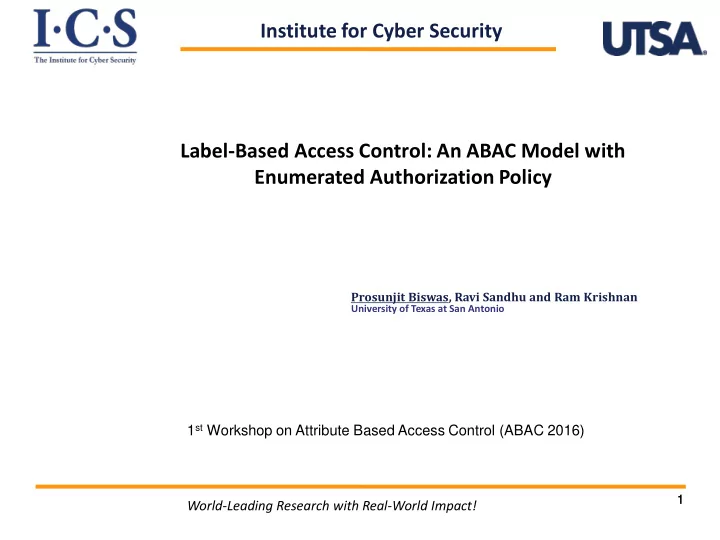

Institute for Cyber Security Label-Based Access Control: An ABAC Model with Enumerated Authorization Policy Prosunjit Biswas, Ravi Sandhu and Ram Krishnan University of Texas at San Antonio 1 st Workshop on Attribute Based Access Control (ABAC 2016) 1 1 World-Leading Research with Real-World Impact!
Outline Summary Background & motivation Enumerated authorization policy ABAC model Relationship with existing models Expressive power of LaBAC Conclusion 2 2 World-Leading Research with Real-World Impact!
Summary We present an enumerated authorization policy ABAC model and understand its relationship with traditional access control models. 3 3 World-Leading Research with Real-World Impact!
Background and Motivation
authorization policy • • Boolean expression Set of tuples • • {(age(u),19), (age(u),20), …. E.g.: age(u)>18 • Models: ABAC α , HGABAC (age(u),100)} [assuming range upper bound <=100] • Models: Policy Machine, 2- sorted-RBAC 5 5 World-Leading Research with Real-World Impact!
Logical-formula Auth. Policy Many ways to set up a policy - Auth read ( Auth read allows manager to read TS objects from home or office) . 6 6 World-Leading Research with Real-World Impact!
Logical-formula Auth. Policy Update Auth read so that manager can no longer read TS objects from home 7 7 World-Leading Research with Real-World Impact!
Enumerated Auth. Policy Auth read ≡ {(mng, home, TS), (mng,office,TS)} Auth` read ≡ { (mng, home, TS), (mng,office,TS)} 8 8 World-Leading Research with Real-World Impact!
Logical formula vs enumerated policy Rich & flexible Homogeneous Pros • • Easy to setup Micro policy • • Concise Easy to update • • Logical formula Enumerated authorization policy authorization policy Large in size Difficult to update • • Cons Difficult to setup Monolithic • • Heterogeneous • 9 9 World-Leading Research with Real-World Impact!
LaBAC: Label-Based Access Control
Characteristics Label vs Attribute Labels are attributes with tighter semantics Salient features of LaBAC Finite domain ABAC Simple enumerated ABAC model
Family of LaBAC models
LaBAC: Core model Figure 1 Salient Characteristics: 1. One user and object attribute 2. Atomic valued tuples 3. Tuples represent micro-policies Examples UL={ manager,employee } OL={TS,S} Tuple1= (manager,TS) Figure 2 Policy read = {tuple1, tuple2…}
LaBAC: Hierarchical model Figure 1 Examples ULH={(manager,employee)} OLH={(protected, public)} Policy a = {(employee,protected)} ImpliedPolicy a = { (employee, protected), (manager, Figure 2 proteced), (employee,public), (manager, public}
LaBAC: Constrained model Figure 1 Examples uLabel assgn. cons: a user cannot be both manager & director. Session assgn. cons: at most one value can be activated in a session. oLabel assgn. cons: A object cannot be both private & public Policy cons: (employee, TS) can never be used.
Relationship of LaBAC with other enumerated policy models
LaBAC equivalent to 2-sorted-RBAC Figure 1: 2-sorted-RBAC Figure 2: LaBAC 2-sorted-RBAC vs LaBAC: 1. Use of attributes 2. Separation of object and action from permission
LaBAC as an instance of Policy Machine Policy Machine mini Only ASSIGN and ASSOCIATION relation Default policy class Configuration of LaBAC in Policy Machine mini
Flexibility in expressing traditional models
Expressiveness of LaBAC models
LBAC in LaBAC LBAC assumptions: 1. Tranquility 2. Object operation: creation only
Micro-policy in LaBAC
Micro-policy in LaBAC micro-policy as the smallest unit of administration Example of a micro-policy: (manager, TS)
What is next Any other form of representation for authorization policy? How expressive power of enumerated authorization policy is compared with that of logical-formula auth. policy? What would be the cost of storing large number of enumerated tuples?
Recommend
More recommend